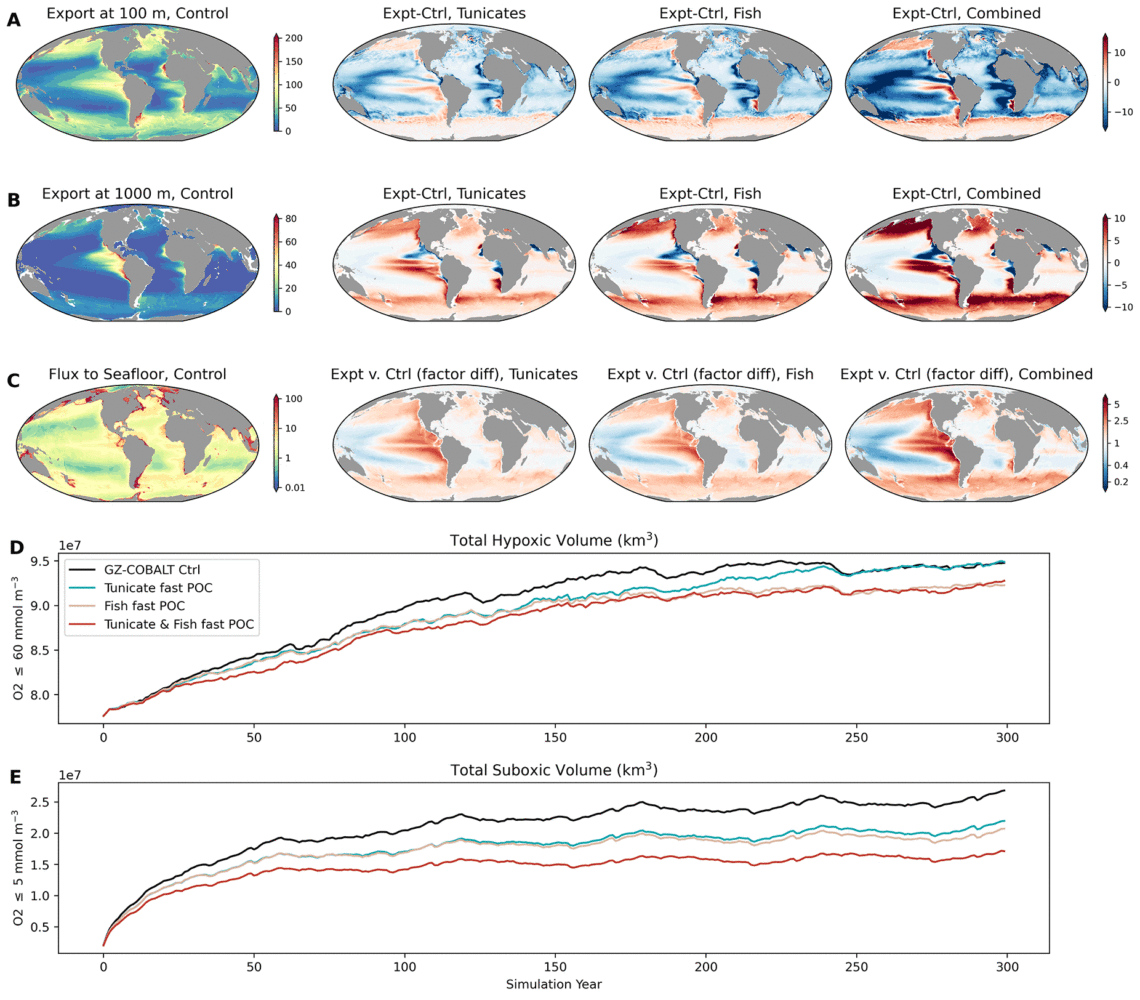February 8th, 2024
Key Findings
- The authors used a global ocean biogeochemical model to investigate a key component of the biological pump: the contribution of fast-sinking detritus from marine organisms (tunicates and fish) to ocean biogeochemical cycles.
- The results highlight potential missing gaps in representation of the ocean’s biological pump in climate models, and how incorporating previously under-studied mechanisms for fast transfer efficiency of detritus may improve representations of oxygen minimum zones (OMZs) and water column denitrification.
- Fast sinking detritus sinks 10 times faster than bulk detritus, and using an ocean-only experiment, run for 300 years, surface export and net primary production decreased, particularly in the subtropical gyres
- Deep carbon sequestration and transfer efficiency increased in much of the oceans, particularly in upwelling zones and high latitudes. A key exception was at the OMZs, where the fast-sinking detritus actually served to reduce OMZ size and thus, decrease transfer efficiency and the remineralization length scale of particulate organic carbon.
- Associated with the improvement in OMZ biases, common to global biogeochemical models, water column denitrification also was reduced, resulting in improvements in nitrate concentrations in the mesopelagic.
- Comparisons with benthic oxygen consumption data suggests that the observations may accommodate increases in transfer efficiency associated with fast-sinking detritus.
Jessica Y. Luo, Charles A. Stock, John P. Dunne, Grace K. Saba, Lauren Cook. Geophysical Research Letters. DOI: 10.1029/2023GL107052
Marine ecosystems play a critical role in the global carbon cycle through the food web regulation of air-sea carbon fluxes and the transfer of particulate matter from the upper oceans to depth. Recent evidence has suggested that the detritus from fishes and gelatinous zooplankton, specifically the pelagic tunicates such as salps and pyrosomes, may have a disproportionate impact on the ocean’s biological pump due to them sinking approximately ten times faster than bulk detritus. These fluxes result in increased sequestration of particulate carbon and nutrients into the deep oceans, but their impact on biogeochemical cycles at depth is poorly understood.
The authors investigated the sensitivity of deep ocean carbon, oxygen, and nutrient cycles to fast-sinking detritus from tunicates and fishes. They found that the fast-sinking detritus decreased surface productivity and export, as well as the size of ocean oxygen minimum zones (OMZs).
This has not previously been investigated in a global ocean biogeochemical model. For this study, the authors incorporated fast-sinking detritus from pelagic tunicates and fishes into a modified version of GFDL’s ocean biogeochemical model COBALT (GZ-COBALT). These results highlight potential missing gaps in the representation of the ocean’s biological pump, and how incorporating previously under-studied mechanisms for fast transfer efficiency of detritus may improve model representations of OMZs and water column denitrification.
The authors also examined whether observational evidence of seafloor oxygen consumption could support the increased detrital fluxes (and respiration) at depth, and found that even with the increased oxygen consumption, the modeled values were still below the observations. This suggests that these processes could be realistically incorporated into future generations of Earth System Models.



